
Mazda Motor Corporation, also known as simply Mazda, is a Japanese multinational automotive manufacturer headquartered in Fuchū, Hiroshima, Japan. The company was founded on January 30, 1920, as Toyo Cork Kogyo Co., Ltd., a cork-making factory, by Jujiro Matsuda. It changed its name to Toyo Kogyo Co., Ltd. in 1927 and started producing vehicles in 1931. The name Mazda was derived from Ahura Mazda, the god of harmony, intelligence and wisdom in Zoroastrianism, as well as from the surname of the founder. Mazda is one of the largest automakers in Japan and the world. In 2015, it produced 1.5 million vehicles for global sales, of which nearly one million were made in Japan and the rest in various other countries. It ranked as the 15th-largest automaker by production volume globally in 2015. Mazda is known for its innovative technologies, such as the Wankel engine, the SkyActiv platform, and the Kodo Design language. It also has a long history of motorsport involvement, winning the 24 Hours of Le Mans in 1991 with the rotary-powered Mazda 787B. Mazda has several alliances and partnerships with other automakers, such as Toyota, Nissan, Isuzu, Suzuki and Ford.

Mazdaspeed was Mazda's in-house performance division. The company was a grassroots racing team in Japan. Owned by Mazda Motor Corporation, they built production model vehicles, became involved in motorsports development, and offered performance parts and accessories. Mazda has phased out Mazdaspeed branding and has not offered a Mazdaspeed trim since the 2013 Mazdaspeed3.

The 24 Hours of Daytona, also known as the Rolex 24 At Daytona for sponsorship reasons, is a 24-hour sports car endurance race held annually at Daytona International Speedway in Daytona Beach, Florida. It is run on the Sports Car Course layout, a 3.56-mile (5.73 km) combined road course that uses most of the tri-oval plus an infield road course. Held on the last weekend of January or first weekend of February as part of Speedweeks, it is the first major automobile race of the year in North America. The race is sanctioned by IMSA and is the first race of the season for the IMSA SportsCar Championship.
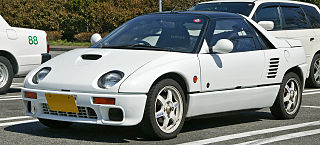
The Autozam AZ-1, known by the framecode PG6SA, is a mid-engined kei-class sports car, designed and manufactured by Mazda under its Autozam brand. Suzuki provided the engine as well as the inspiration for the design.

The Mazda 787 and its derivative 787B are Group C sports prototype racing cars that were developed by Japanese automobile manufacturer Mazda for use in the World Sportscar Championship, All Japan Sports Prototype Championship, and the 24 Hours of Le Mans from 1990 to 1991. Designed to combine a mixture of the Fédération Internationale du Sport Automobile (FISA) Group C regulations with the International Motor Sports Association (IMSA) GTP regulations, the 787s were the last Wankel rotary-powered racing cars to compete in the World and Japanese championships, using Mazda's R26B engine.
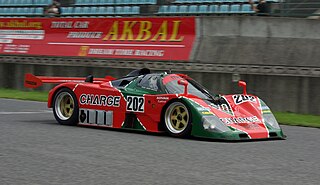
The Mazda 767/767B are prototype racing cars that were built by Mazdaspeed for the 24 Hours of Le Mans running under the IMSA-spec GTP class. The 767 replaced the 757 in 1988, upgrading to a newer and larger 4-rotor 13J Wankel engine which produced nearly 600 hp (450 kW).
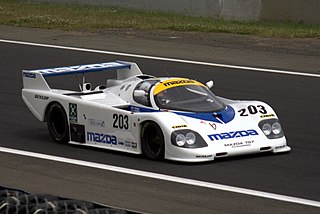
The Mazda 757 is a prototype racing car built by Mazdaspeed for the 24 Hours of Le Mans running under the IMSA-spec GTP class. It replaced the previous lineage of Group C2 class cars which ended with the 737C and was the first chassis built entirely by Mazdaspeed and designed by Nigel Stroud. The 747 designation was skipped to avoid confusion with the second generation Mazda RX-7, which was developed under the codename P747. The 757 used a new 3-rotor 13G Wankel engine.
The Mazda 727C is a prototype racing car that was built for Mazdaspeed for the 24 Hours of Le Mans in the Group C2 class. It replaced the 717C in 1984 as an evolution of the Mooncraft-built design, and used the same 2-rotor 13B Wankel engine as the previous model.
The Mazda 717C is a prototype racing car built for Mazdaspeed for the 24 Hours of Le Mans under the Group C Junior formula. It was the first racecar built by Mazda since the ending of their running in GT with the RX-7 in 1982. It used a 2-rotor 13B Wankel engine, similar to the production engine in the Mazda RX-7. The bodywork and chassis were actually built by Mooncraft racing with assistance from Mazda.

Group C was a category of sports car racing introduced by the FIA in 1982 and continuing until 1993, with Group A for touring cars and Group B for GTs.

The 1987 24 Hours of Le Mans was the 55th Grand Prix of Endurance as well as the fifth round of the 1987 World Sports-Prototype Championship. It took place at the Circuit de la Sarthe, France, on the 13 and 14 June 1987. Jaguar was a strong contender, have won the four preceding rounds of the Championship. The Porsche works team had installed a new 3-litre engine into their 962s but their turbo engines would test their fuel economy.

The 1985 24 Hours of Le Mans was the 53rd Grand Prix of Endurance, as well as the fourth round of the 1985 World Endurance Championship. It took place at the Circuit de la Sarthe, France, on 15 and 16 June 1985. The works Porsche team returned, with a Group C version of the 962. As favourites, they could expect from their customer teams and the works Lancias. In qualifying, Hans-Joachim Stuck set a new lap record in his works Porsche, with an average speed over 250 km/h for the first time. Mercedes returned for the first time in 30 years, as engine supplier to the Sauber team. The return was short-lived though, as the car got airborne in practice and crashed. With tighter fuel regulations this year from FISA, the teams would have to be more mindful of fuel economy and speed. However, from the start the Joest and Richard Lloyd Racing teams had the measure of the field. Working in tandem, Klaus Ludwig and Jonathon Palmer took turns leading and slipstreaming behind the other. Then at 9pm Jean-Claude Andruet had a major accident when his WM had a tyre blow out a high speed at the Mulsanne kink, sending him into the Armco barriers. Andruet was uninjured, but the race went behind the pace-cars for a half-hour as repairs were done. Just as the race resumed James Weaver pitted the RLR Porsche with an engine misfire. Traced to a faulty sensor, they returned to the race in 7th.
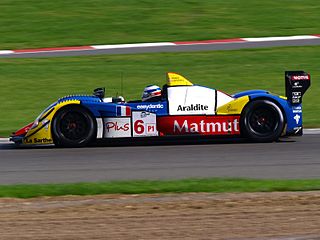
Courage Compétition was a racing team and chassis constructor company now owned by Oreca, based in Le Mans, France, near the Circuit de la Sarthe. It was founded by Yves Courage, a French race driver who ran hillclimbs before founding the company. Following the purchase of Courage by Oreca in 2007, Yves Courage has refounded the company as Courage Technology in 2010, attempting to develop electric racing cars.
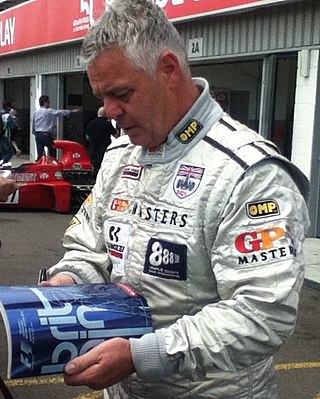
The 1992 Sportscar World Championship season was the 40th and final season of FIA World Sportscar Championship motor racing. It featured the 1992 FIA Sportscar World Championship, which was contested over a six race series which ran from 26 April to 18 October 1992. The championship was open to Group C Sportscars.

The Mazda MXR-01 is a Group C sports prototype that was used by Mazda's factory team Mazdaspeed in the 1992 World Sportscar Championship season. It would be the final Mazda entry in sports car racing since the inception of its Le Mans project in 1983. It was based on the Jaguar XJR-14.
Advanced Engine Research, Ltd. is an auto racing engine manufacturer based in Basildon, Essex, England. Established in 1997, AER has developed winning engines for a number of high-profile international race series in sports car, prototype racing, rallying, touring car, and open wheel racing. They have designed engines derived from road car platforms, but their emphasis is on clean sheet designed engines with a focus on electronics and turbochargers. Their engines have raced in the 24 Hours of Le Mans, the World Endurance Championship (WEC), the European Le Mans Series (ELMS), the United SportsCar Championship (TUSC), GP3, British Touring Car Championship (BTCC), Nissan/Renault World Series, Grand-Am, Paris Dakar and FIA Sportscar Championship. They have worked with a number of manufacturers including Mazda, Ford, Hyundai, MG/Rover, Nissan, and Toyota. In 2012, AER developed and built Formula One turbo test engines to current rules and in July 2012, AER was chosen as engine partner and supplier to the new GP3 racing series. They currently supply engines for the Indy Lights series.

The Mazda RX-792P is a sports prototype racing car built for the IMSA GT Championship's GTP category for Mazda. Its career was short lived, with only two cars running in 1992 before the project was abandoned.
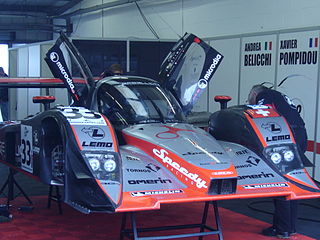
The Lola B08/80 is a Le Mans Prototype built by Lola Cars International. It is effectively the LMP2 version of the larger Lola B08/60; they are the first closed-cockpit sports prototypes built by Lola since the T92/10 of 1992. The B08/80 is optimised for the smaller engines and lighter weight of the LMP2 category in comparison to the larger and heavier B08/60.
Pierre Dieudonné is a Belgian auto racing driver and motoring journalist.
The Lola T616 is a sports prototype built by Lola Cars to the Group C2 and IMSA GTP regulations. It was built with the intention to compete in the IMSA GT Championship and the World Sportscar Championship, and became the second Mazda-powered prototype to score a class win at the 24 Hours of Le Mans after the 717C triumphed in the same C2 class at the 1983 24 Hours of Le Mans.















